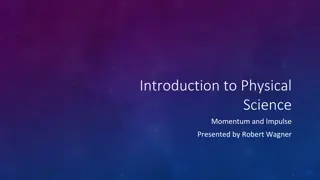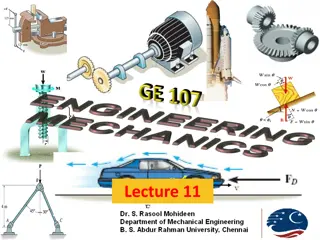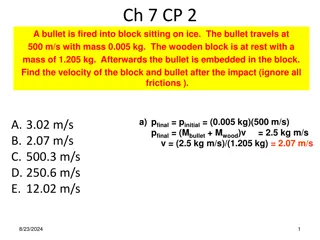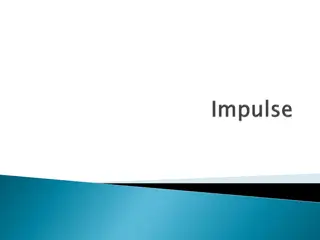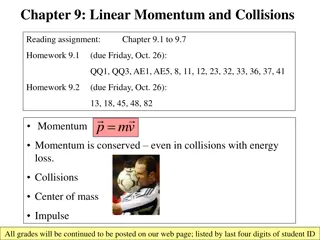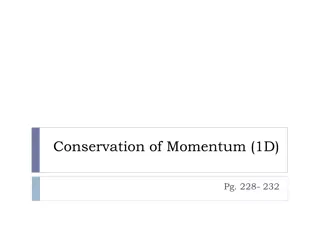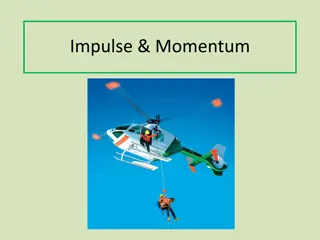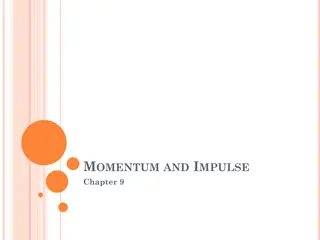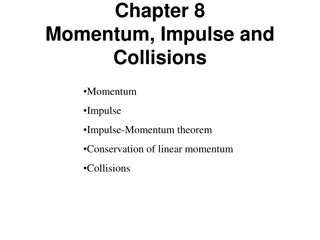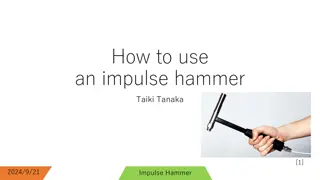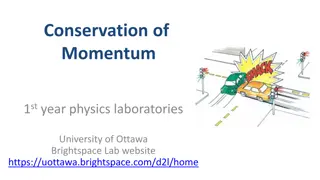Understanding Momentum and Impulse in Sports
Momentum and impulse play a crucial role in sports performance. In a volleyball scenario where a ball is hit back by a player, understanding the change in speed, velocity, and force exerted can enhance gameplay strategies. Momentum is a key physics concept that affects an object's motion and the force required to stop or change its direction. By applying force over a period of time, players can effectively alter the momentum of objects, impacting the game dynamics.
Download Presentation

Please find below an Image/Link to download the presentation.
The content on the website is provided AS IS for your information and personal use only. It may not be sold, licensed, or shared on other websites without obtaining consent from the author. Download presentation by click this link. If you encounter any issues during the download, it is possible that the publisher has removed the file from their server.
E N D
Presentation Transcript
A ball is moving toward a volleyball player with the speed of 5 m/s. The player hits it back. The ball is moving away from him with the speed of 4 m/s. What is the change in speed? What is the change in velocity? If the contact with player s hand lasts 1 second and m=1 kg, what force was exerted by the player? Did you use change in speed to calculate force or change in velocity? Why it that so so so important? Can the same change in velocity be achieved through longer contact time (player moving the arm back and then forward). Will the force be greater or smaller?
LINEAR MOMENTUM & IMPULSE
(Linear) Momentum, p is mass times velocity vector! p = mv (p) = kg m/s a 1 kg object moving at 1000 m/s has the same momentum as a 1000 kg object moving at 1 m/s (p = 1000 kg m/s) a roller skate rolling has more momentum than stationary truck.
Momentum is a commonly used term in sports. When a sports announcer says that a team has the momentum they mean that the team is really on the move and is going to be hard to stop. The term momentum is a physics concept. Any object with momentum is going to be hard to stop or change. To change the motion of such an object, it is necessary to apply a force against its motion for a given period of time. The more momentum that an object has, the harder that it is to stop. Thus, it would require a greater amount of force or a longer amount of time or both to bring such an object to a halt. As the force acts upon the object for a given amount of time, the object's velocity is changed; and hence, the object's momentum is changed.
Review What is momentum? If an object is at rest, does it have momentum? What is the equation for momentum? What are the units for momentum? If I double an object s mass and keep its velocity the same, what will happen to its momentum? If I double the velocity and cut the mass in half, what will happen to the momentum?
How can the momentum of an object be changed? By changing its mass, or, more usually, by exerting a force causing an acceleration that changes its velocity. Let s go back to Newton s second law: F = ma. Actually, Newton formulated his second law as: p F = t Force = time rate of change of momentum p is the change in momentum produced by the force F in time t (mv) t v t F = = m = ma If the mass doesn t change, then
p F = t is in fact the form in which you should remember the second law of motion since the law in the form F = ma is actually, as we have seen mathematically, a special case it can not be applied to situations in which mass can change. Physics is fun If the mass does change, then F = p t Physics is fun Watch me, please t= (mv) = v m Watch me, please t
p we can get a very useful form of Newton s 2. law: F = t F t= p p = mv - mu F tis called the impulse of the force. impulse (action of a force F over time t ) will produce change in momentum p units: (F t) = Ns Ns = kg m/s
Quick Checks How do you stop an object with momentum? Is it harder to stop an object with more mass or less mass? Compare the forces I would need to exert to stop a bowling ball and a tennis ball traveling at the same speed. What happens when an unbalanced force acts on an object? What is acceleration? When an object s velocity changes, so does its What causes a change in momentum? What is the equation we use to represent impulse? Give me 2 examples of impulses.
Achieving the same change in momentum over a long time requires smaller force and over a short time greater force. p = F t Let s think about the time it takes to slow the truck to zero. 10 kg m/s = (10N)(1s) = (5N)(2s) = (1N)(10s) = or, you could exert a huge force over very short period of time. You could stop it with your own force just if you exert it over a long, long period of time. (0.1N)(100s) = And the story goes on .
Often you want to reduce the momentum of an object to zero but with minimal impact force (or injury). How to do it? Try to maximize the time of interaction; this waystopping force is decreased. Getting smart and smarter by knowing physics: Car crash on a highway, where there s either a concrete wall or a barbed-wire fence to crash into. Which to choose? Naturally, the wire fence your momentum will be decreased by the same amount, so the impulse to stop you is the same, but with the wire fence, you extend the time of impact, so decrease the force. Bend your knees when you jump down from high! Try keeping your knees stiff while landing it hurts! (only try for a small jump, otherwise you could get injured ) Bending the knees extends the time for momentum to go to zero, by about 10-20 times, so forces are 10-20 times less.
Safety net used by acrobats, increases impact time, decreases the forces. Catching a ball let your hand move backward with the ball after contact Bungee jumping Riding with the punch, when boxing, rather than moving into By moving away, the time of contact is extended, so force is less than if he hadn t moved. By moving into the glove, he is lessening the time of contact, leading to a greater force, a bigger ouch! Wearing the gloves when boxing versus boxing with bare fists.
You wouldnt believe me, but this is a pure luck!!!!
Sometimes you want to increase the force over a short time This is how in karate (tae kwon do), an expert can break a stack of bricks with a blow of a hand: Bring in arm with tremendous speed (large momentum), that is quickly reduced on impact with the bricks. The shorter the time, the larger the force on the bricks.
Practice Explain how the problem above is an example of impulse.
Determine the change in impulse due to a time varying force Formulas we had are for the constant force. What if the force changes over time t ? The graph shows the variation with time of the force on the football of mass 0.5 kg. ball was given an impulse of approximately 100x0.01 = 1Ns during this 0.01s. area under graph is the total impulse given to the ball 2x(100x0.05)/2 = 5 Ns F t= p p = 5 kg m/s p = m v v = 10 m/s v = u + v Change in momentum, p, in time t is the area under the graph force vs. time.
In actuality one is much more likely to use the measurement of the speed of the football to estimate the average force that is exerted by the foot on the football. The time that the foot is in contact with the ball can be measured electronically. Favg = m v/ t
A possible force vs. time curve for a ball struck by a bat is shown in the figure. 6.7 Ns (a) Estimate the impulse delivered to the ball. (b) This 0.25 kg ball was initially moving toward the bat at a speed of 20 m/s. Calculate the exit speed of the ball. ??????= ????????+ ? ?= 5 kg m/s 6 kg m/s = 1 kg m/s V = 4 m/s
Till now we were concentrated on ONE object. Now we move to the system of (usually) two objects exerting strong forces over a short time intervals on each other like: collisions, explosions, ejections
HW: odd numbers on HW packet. What were our objectives today? What did you learn about our objectives? Give few examples where you can apply what you ve learnt today And now Complete the exit ticket silently, on your own
Collisions conservation of momentum collisions can be very complicated two objects bang into each other and exert strong forces over short time intervals which are very hard to measure fortunately, we can predict the future without going into pesky details of force. What will help us is the law of conservation of linear momentum:
Law of Conservation of Momentum consider system: particle 1 and particle 2 collide with one another. velocities just before interaction (collision) velocities just after interaction (collision) m1 (p1 + p2 = p) v1 u1 pafter = pbefore u2 v2 m2 m1v1 + m2v2 = m1u1 + m2u2 The total linear momentum of a system of interacting particles is conserved - remains constant, provided there is no resultant external force. Such a system is called an isolated system . HA HA
Certain situations (collisions, explosions, ejections) do not allow detailed knowledge of forces (strength, direction, duration) or acceleration. Of course that these situations must follow Newton s laws. The only problem is that it is difficult to see exactly how to apply them. One cannot easily measure neither forces involved in the collision nor acceleration (velocity appears to be instantaneously acquired). The law of conservation of momentum gives us an easy and elegant way to predict the outcome without knowing forces involved in process. It is much easier to measure velocities and masses before and after interaction. WE CAN APPLY THE LAW OF CONSERVATION OF MOMENTUM TO COLLISIONS AND EXPLOSIONS (EJECTIONS) IF DURING INTERACTION THE NET EXTERNAL FORCE IS ZERO OR IT CAN BE NEGLECTED. Example: baseball is struck with a bat duration of the collision is about 0.01 s, and the average force the bat exerts on the ball is several thousand Newtons what is much greater than the force of gravity, so you can ignore it. And as we consider velocities just before and just after interaction, there is no much change due to gravity. The system can be considered isolated and momentum is conserved.
beauty of the law of conservation of momentum if we know what the objects were doing before they collided, we can figure out what can happen after they collide. We can work backward sometimes to figure out from the collision scene what was going on before the collision.
Momentum is conserved in every isolated system. Internal forces can never change momentum of the system.
Example how to use law of conservation of momentum in the case of ejections or explosions.
A 60.0-kg astronaut is on a space walk when her tether line breaks. She throws her 10.0-kg oxygen tank away from the shuttle with a speed of 12.0 m/s to propel herself back to the shuttle. What is her velocity? after before 12.0 m/s 60 10 70 v1 = ? u = 0 pbefore = pafter 0 =m1 v1 + m2 v2 0 = 60.0 v1 + 10.0 (12.0) v1= 2.0 m/s moving in the negative direction means toward shuttle
Very similar case is spaceship propulsion which is actually example of conservation of momentum. Since no outside forces act on the system (spaceship + its fuel) or it is very small compared to the explosion, the momentum gained by fuel ejected in the backward direction must be balanced by forward momentum gained by the spaceship. hot gas ejected at very high speed pbefore = pafter 0 = m1 v1 + m2 v2 m1 v1 = - m2 v2 the same as untied balloon.
Similar examples are: recoil of the firing gun, recoil of the firing cannon, ice-skater s recoil, throwing of the package from the boat etc.
however, the smaller skater acquires a larger speed (due to larger acc.) than the larger skater. Two stationary ice skaters push off both skaters exert equal forces on each other momentum is conserved! pbefore = pafter 0 = m1 v1 + m2 v2 m1 v1 = - m2 v2
If you consider momentum: before = 0, so after must be zero too, therefore the speeds gained (while the force of interaction acted) are pretty different.
Example how to use law of conservation of momentum in the case of collisions.
There are two fish in the sea. A 6 kg fish and a 2 kg fish. The big fish swallows the small one. What is its velocity immediately after lunch? a. the big fish swims at 1 m/s toward and swallows the small fish that is at rest. before lunch after lunch Net external force is zero. Momentum is conserved. 1 m/s 8 2 6 v = ? p before lunch = p after lunch momentum is vector, direction matters; choose positive direction in the direction of big fish. Mu1 + mu2 = (M + m)v + (6 kg)(1 m/s) + (2 kg)(0 m/s) = (6kg + 2 kg) v 6 kg m/s = (8 kg) v v = 0.75 m/sin the direction of the large fish before lunch
+ b. Suppose the small fish is not at rest but is swimming toward the large fish at 2 m/s. before lunch -2 m/s after lunch 1 m/s 8 2 6 v = ? p before lunch = p after lunch Mu1 + mu2 = (M+m)v (6 ) (1 ) + (2 ) ( 2 ) = (6 + 2 ) v 6 4 = 8 v in the direction of the large fish before lunch The negative momentum of the small fish is very effective in slowing the large fish. v = 0.25 m/s
+ c. Small fish swims toward the large fish at 3 m/s. before lunch -3 m/s after lunch 1 m/s 8 2 6 v = ? p before lunch = p after lunch Mu1 + mu2 = (M+m)v (6 ) (1 ) + (2 ) ( 3 ) = (6 + 2 ) v 6 6 = (8 ) v v = 0 m/s fish have equal and opposite momenta. Zero momentum before lunch is equal to zero momentum after lunch, and both fish come to a halt.
+ d. Small fish swims toward the large fish at 4 m/s. before lunch -4 m/s after lunch 1 m/s 8 2 6 v = ? p before lunch = p after lunch Mu1 + mu2 = (M+m)v (6 ) (1 ) + (2 ) ( 4) = (6 + 2 ) v 6 8 = 8 v v = 0.25 m/s The minus sign tells us that after lunch the two-fish system moves in a direction opposite to the large fish s direction before lunch.
A red ball traveling with a speed of 2 m/s along the x-axis hits the eight ball. After the collision, the red ball travels with a speed of 1.6 m/s in a direction 37o below the positive x-axis. The two balls have equal mass. At what angle will the eight ball fall in the side pocket? What is the speed of the blue (8th) ball after collision. v2 after collision: before collision: 8 u2 = 0 u1 2 370 8 the point of collision pbefore = pafter v1 m u1+ 0 = m v1cos 370+ m v2cos 2 v2cos 2 = u1 - v1 cos 370= 0.72 m/s (1) 0 = - m v1sin 370+ m v2sin 2 v2sin 2 = v1 sin 370= 0.96 m/s in x direction in y direction (2) direction of v2 ; (2)/(1) (2) v2 = 0.96 / sin 530 v2 = 1.2 m/s tan 2 = 1.33 2 = 530
Derivation of the Law of Conservation of Momentum consider system: particle 1 and particle 2 collide with one another with no net external force acting on neither of them. velocities just before interaction (collision) forces during collision velocities just after interaction (collision) m1 F1 v1 u1 F2 u2 v2 m2 During the time interval the collision takes place, t, impulse F1 t given to particle 1 will cause its momentum change p1. During the same time interval impulse F2 t will change particle s 2 momentum by p2.
(p1 + p2 = p) particle 1 : F1 t = p1 particle 2 : F2 t = p2 F1 = F2(N3.L) p2 = p1 What one object loses in the collision the other one gains. p1+ p2 = 0 (p1 + p2 ) = 0 p = 0 pafter = pbefore Total momentum of a system before and after collision is the same. Conservation of Momentum: if no external force act on a system, the total momentum of the system is conserved it will not change. Such a system is called an isolated system . This argument can be extended up to any number of interacting particles so long as the system of particles is still isolated. blahblah


